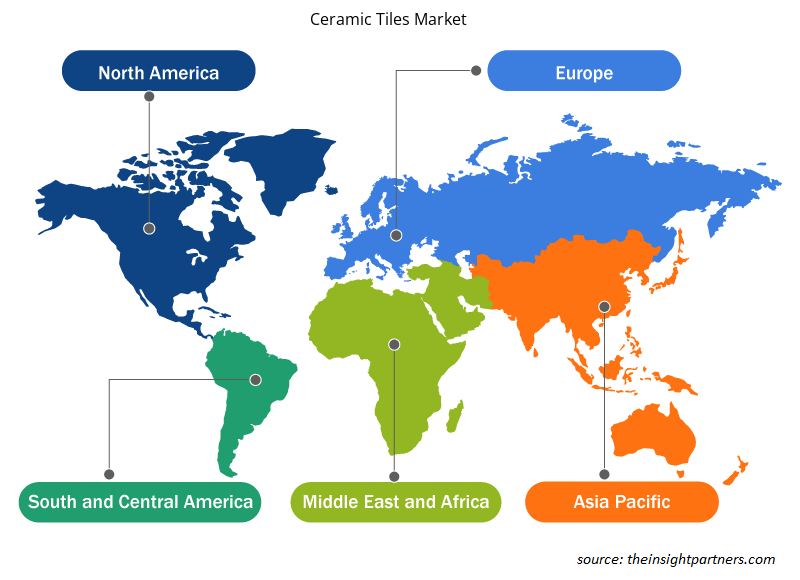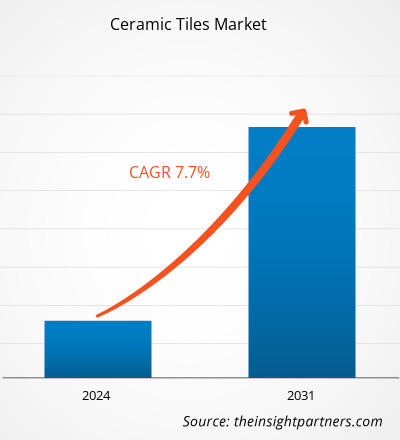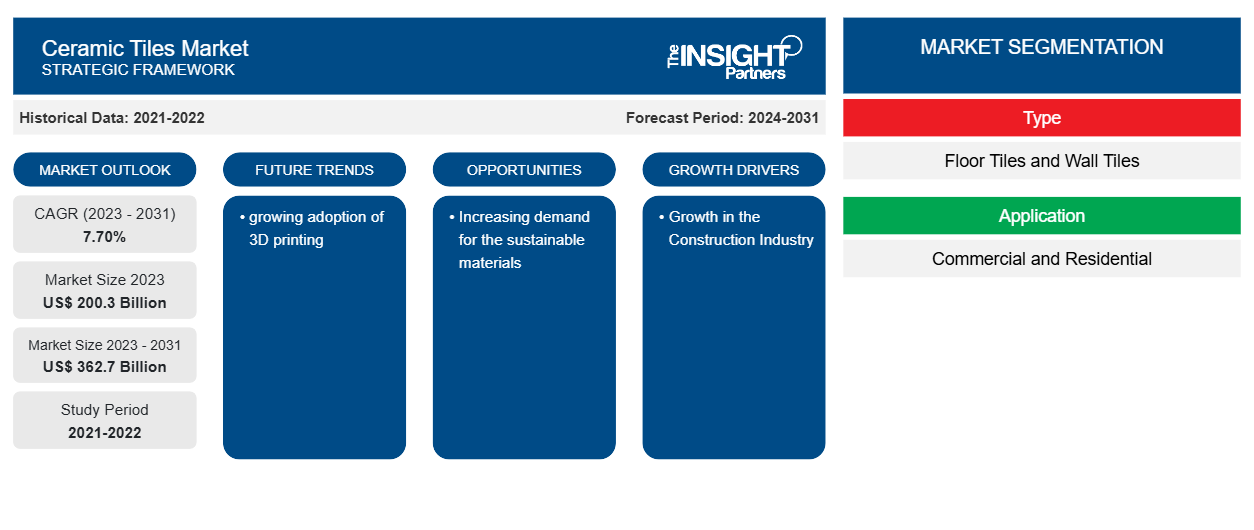Se proyecta que el tamaño del mercado de baldosas cerámicas alcance los 362,7 mil millones de dólares estadounidenses para 2031, frente a los 200,3 mil millones de dólares estadounidenses en 2023. Se espera que el mercado registre una CAGR del 7,70 % entre 2023 y 2031. La demanda continua del sector comercial y residencial ha respaldado el crecimiento del mercado de baldosas cerámicas. Además, la creciente conciencia y adopción de la tecnología de impresión 3D en el sector cerámico es una de las tendencias futuras en la industria.
Análisis del mercado de baldosas cerámicas
Se prevé que la demanda de baldosas de cerámica para pisos represente la mayor participación de mercado. Algunos de los principales factores que impulsan la adopción de baldosas de cerámica para pisos son el bajo costo, la línea de productos más amplia y la facilidad de instalación. En términos geográficos, el mercado mundial de baldosas de cerámica está dominado por Asia Pacífico. La alta población y la creciente industria de la construcción son algunos de los principales factores que se prevé que dominen el mercado de baldosas de cerámica de Asia. Además, los gobiernos de los países asiáticos se han centrado en atraer inversión extranjera directa para expandir su infraestructura comercial. Estas iniciativas gubernamentales están apoyando aún más el crecimiento del mercado.
Descripción general del mercado de baldosas cerámicas
Las baldosas cerámicas han reemplazado notablemente a los productos de piedra natural debido a su mayor durabilidad y precios más bajos. Por lo tanto, debido a su naturaleza rentable, la adopción de baldosas cerámicas ha aumentado en países sensibles a los costos como China, India y algunos de los países de Oriente Medio. Aparte de los factores mencionados anteriormente, la resistencia a la humedad, antipolvo y antideformación son algunos de los otros atributos que respaldan aún más el crecimiento del mercado. Sin embargo, una gran cantidad de fabricantes de baldosas cerámicas en la industria es uno de los desafíos para el mercado mundial de baldosas cerámicas. Además, la región europea también está generando oportunidades lucrativas para el mercado de baldosas cerámicas debido a la mayor demanda de casas estéticas en la región. Además, en los últimos años, el sector de la construcción en Alemania y el Reino Unido ha mostrado un crecimiento positivo.
Personalice este informe según sus necesidades
Obtendrá personalización en cualquier informe, sin cargo, incluidas partes de este informe o análisis a nivel de país, paquete de datos de Excel, así como también grandes ofertas y descuentos para empresas emergentes y universidades.
-
Obtenga las principales tendencias clave del mercado de este informe.Esta muestra GRATUITA incluirá análisis de datos, desde tendencias del mercado hasta estimaciones y pronósticos.
Impulsores y oportunidades del mercado de baldosas cerámicas
Crecimiento en la industria de la construcción
El crecimiento continuo de la población y la urbanización son algunos de los factores que impulsan la industria de la construcción. Según los datos proporcionados por Macrotrends en 2024, la población mundial en 2020 era de 7.800 millones; la cifra llegó a 8.000 millones en 2022. Esto muestra un aumento constante de la población. Además, según las estadísticas proporcionadas por las Naciones Unidas, se prevé que la población mundial alcance los 8.500 millones en 2030. Por lo tanto, un aumento de la población aumentará directamente la demanda de construcción residencial, comercial y de infraestructura. Tal aumento en la industria de la construcción ha aumentado aún más la demanda de baldosas cerámicas, lo que en última instancia impulsa el mercado.
Creciente demanda de materiales sostenibles
La demanda de materiales ecológicos en el sector de la construcción está aumentando rápidamente debido a las iniciativas para reducir la huella de carbono. Las estrictas normas impuestas por los gobiernos de todo el mundo, especialmente por los países desarrollados, están obligando a los fabricantes de materiales de construcción a fabricar productos que emitan bajas emisiones de carbono. Los fabricantes de baldosas cerámicas del sector están llevando a cabo amplias actividades de investigación y desarrollo para introducir productos con bajas huellas de carbono. Se prevé que estas actividades creen oportunidades lucrativas para el mercado de baldosas cerámicas.
Análisis de segmentación del informe de mercado de baldosas cerámicas
Los segmentos clave que contribuyeron a la derivación del análisis del mercado de baldosas cerámicas son el tipo y la aplicación.
- Según el tipo, el mercado de baldosas cerámicas se divide en baldosas para pisos y baldosas para paredes. El segmento de baldosas para pisos tuvo una mayor participación de mercado en 2023.
- Por aplicación, el mercado se segmenta en comercial y residencial. El segmento residencial tuvo la mayor participación del mercado en 2023.
Análisis de la cuota de mercado de baldosas cerámicas por geografía
El alcance geográfico del informe del mercado de baldosas cerámicas se divide principalmente en cinco regiones: América del Norte, Asia Pacífico, Europa, Medio Oriente y África, y América del Sur / América del Sur y Central.
La región de Asia Pacífico tuvo la mayor participación en el mercado mundial. Algunos de los factores que impulsan la demanda de baldosas cerámicas en la región son la alta población y la demanda de productos rentables. El mercado de Asia Pacífico se clasifica además por país en Australia, China, India, Japón, Corea del Sur y el resto de Asia Pacífico. Según los datos proporcionados por el Centro de Información Económica y Censo en 2022, el sector de la construcción de China registró unos ingresos de aproximadamente 4 mil millones de dólares estadounidenses en 2022, un crecimiento constante con respecto a 2019. Esta expansión del sector de la construcción afectó directamente al sector de la construcción de forma positiva. Además de China, la India también está tomando algunas iniciativas agresivas para expandir su sector de la construcción. El plan Pradhan Mantri Awas Yojana del gobierno indio ha ayudado a que la industria de la construcción residencial crezca notablemente.
Perspectivas regionales del mercado de baldosas cerámicas
Los analistas de Insight Partners explicaron en detalle las tendencias y los factores regionales que influyen en el mercado de baldosas cerámicas durante el período de pronóstico. Esta sección también analiza los segmentos y la geografía del mercado de baldosas cerámicas en América del Norte, Europa, Asia Pacífico, Oriente Medio y África, y América del Sur y Central.

- Obtenga datos regionales específicos para el mercado de baldosas cerámicas
Alcance del informe de mercado de baldosas cerámicas
| Atributo del informe | Detalles |
|---|---|
| Tamaño del mercado en 2023 | US$ 200,3 mil millones |
| Tamaño del mercado en 2031 | US$ 362,7 mil millones |
| CAGR global (2023 - 2031) | 7,70% |
| Datos históricos | 2021-2022 |
| Período de pronóstico | 2024-2031 |
| Segmentos cubiertos |
Por tipo
|
| Regiones y países cubiertos |
América del norte
|
| Líderes del mercado y perfiles de empresas clave |
|
Densidad de actores del mercado de baldosas cerámicas: comprensión de su impacto en la dinámica empresarial
El mercado de baldosas cerámicas está creciendo rápidamente, impulsado por la creciente demanda de los usuarios finales debido a factores como la evolución de las preferencias de los consumidores, los avances tecnológicos y una mayor conciencia de los beneficios del producto. A medida que aumenta la demanda, las empresas amplían sus ofertas, innovan para satisfacer las necesidades de los consumidores y aprovechan las tendencias emergentes, lo que impulsa aún más el crecimiento del mercado.
La densidad de actores del mercado se refiere a la distribución de las empresas o firmas que operan dentro de un mercado o industria en particular. Indica cuántos competidores (actores del mercado) están presentes en un espacio de mercado determinado en relación con su tamaño o valor total de mercado.
Las principales empresas que operan en el mercado de baldosas cerámicas son:
- Industrias Mohawk, Inc.
- Cerámica de China Co., Ltd.
- Azulejos de Florida, Inc.
- GRUPO LAMOSA, SAB DE CV
- Cerámica Kajaria Limitada
- Porcelanosa Grupo AIE
Descargo de responsabilidad : Las empresas enumeradas anteriormente no están clasificadas en ningún orden particular.

- Obtenga una descripción general de los principales actores clave del mercado de baldosas cerámicas
Noticias y desarrollos recientes del mercado de baldosas cerámicas
El mercado de baldosas cerámicas se evalúa mediante la recopilación de datos cualitativos y cuantitativos a partir de una investigación primaria y secundaria, que incluye publicaciones corporativas importantes, datos de asociaciones y bases de datos. A continuación, se incluye una lista de los avances en el mercado de baldosas cerámicas y las estrategias:
- Atlas Concorde presentó tres nuevas colecciones en Cersaie 2023. Cersaie 2023 es una feria internacional de azulejos de cerámica y muebles de baño. Atlas Concorde presentó tres nuevas colecciones: Marvel Meraviglia, Boost Balance y Marvel Onyx durante el evento. (Fuente: Atlas Concorde, Nota de prensa/Sitio web de la empresa/Boletín informativo, 2023)
- Daltile lanzó seis nuevas colecciones de azulejos: Artcrafted, Divinium, Acreage, Calgary, Pure y Gamma (piedra natural). (Fuente: Daltile, comunicado de prensa/sitio web de la empresa/boletín informativo, 2023)
Informe sobre el mercado de baldosas cerámicas: cobertura y resultados
El informe “Tamaño y pronóstico del mercado de baldosas cerámicas (2021-2031)” proporciona un análisis detallado del mercado que cubre las siguientes áreas:
- Tamaño del mercado y pronóstico a nivel global, regional y nacional para todos los segmentos clave del mercado cubiertos bajo el alcance
- Dinámica del mercado, como impulsores, restricciones y oportunidades clave
- Principales tendencias futuras
- Análisis detallado de las cinco fuerzas de Porter y PEST y FODA
- Análisis del mercado global y regional que cubre las tendencias clave del mercado, los principales actores, las regulaciones y los desarrollos recientes del mercado.
- Análisis del panorama de la industria y de la competencia que abarca la concentración del mercado, el análisis de mapas de calor, los actores destacados y los desarrollos recientes
- Perfiles detallados de empresas
- Análisis histórico (2 años), año base, pronóstico (7 años) con CAGR
- Análisis PEST y FODA
- Tamaño del mercado, valor/volumen: global, regional y nacional
- Industria y panorama competitivo
- Conjunto de datos de Excel
Informes recientes
Testimonios
Razón para comprar
- Toma de decisiones informada
- Comprensión de la dinámica del mercado
- Análisis competitivo
- Información sobre clientes
- Pronósticos del mercado
- Mitigación de riesgos
- Planificación estratégica
- Justificación de la inversión
- Identificación de mercados emergentes
- Mejora de las estrategias de marketing
- Impulso de la eficiencia operativa
- Alineación con las tendencias regulatorias























 Obtenga una muestra gratuita para - Mercado de Azulejos Cerámicos
Obtenga una muestra gratuita para - Mercado de Azulejos Cerámicos